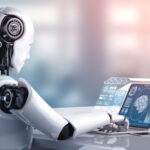All over the internet and in the corporate world, there’s a huge buzz going on about Artificial Intelligence (AI). At first, when AI models like Siri and Alexa became popular, they looked cool. Everyone loved to send Siri on small errands and ask Alexa simple questions. However, today, artificial intelligence has become a thousand times smarter than those voice-controlled personal assistants.
Today, there’s an artificial intelligence tool for everything. Think of writing code, designing a logo, compiling data, producing an advertisement, or recording a song. Anything at all you can think of, there’s an AI tool for the job.
If you’re not really acquainted with technology, you may be wondering what is artificial intelligence, and why is there so much buzz around it. If you’ve been asking this question, then this article is for you. Grab your magnifying lens; let’s zoom in to find out what is artificial intelligence, its basic principles, and why it’s changing the world.
What is Artificial Intelligence
 Artificial intelligence is a field of computer science that focuses on creating intelligent machines that are capable of imitating human behaviors, understanding complex data patterns, making decisions, or performing tasks without bespoke programming.
Artificial intelligence is a field of computer science that focuses on creating intelligent machines that are capable of imitating human behaviors, understanding complex data patterns, making decisions, or performing tasks without bespoke programming.
Artificial intelligence technology allows machines to learn from experience, adapt to new information, and perform complex problem-solving tasks that require human-level intelligence. Its technology is so sophisticated that it can recognize speed, process images, and put up sound arguments using almost all the information available on the internet and beyond.
The integral technologies of AI include machine learning, computer vision, robotics, and natural language processing. All of these combine to create systems that can learn, reason, and perform complex assignments at an intelligence level similar to that of the most articulate humans.
Human vs. Artificial Intelligence
Humans are the ultimate intelligent beings, but artificial intelligence presents a new level of intelligence that rivals that of humanity. To fully understand and appreciate the role of both parties in our evolving world, it’s necessary to draw a distinction between both levels of intelligence.
Consciousness and cognitive prowess make humans the pinnacle of intelligence. Our minds are capable of processing a limitless range of faculties from emotional depth to reasoning and problem-solving. And unlike machines, the things we can do are not limited to our programming. Instead, we can keep learning, adapting, and making decisions based on experience, intuition, ethical considerations, etc.
On the other hand, AI is like a human’s alter ego. Scientists created these machines to replicate certain aspects of human intelligence. Using algorithms and computational power, each of these machines is programmed to become a guru in a specific aspect of human capability.
So, in essence, while a regular human being can sing, write, draw, and create animations, scientists built AI models to perform each of these specific tasks. There’s an AI for writing, another that can sing, another that can draw, and yet another one that can code like a guru. So basically, while human understanding and ability are limitless, an artificial intelligence machine can only be smart enough to do the things for which it is programmed.
Also, it is important to recognize that AI lacks fundamental human qualities like consciousness, emotions, and the richness of human experience that scientists haven’t yet replicated in machines.
Types of Artificial Intelligence Machine
There are many types of artificial intelligence machines. The most popular ones include:
Machine Learning
This kind of artificial intelligence allows machines to learn and improve based on experience, instead of waiting for explicit coding. These machines use statistical models and algorithms to analyze and interpret data while using the information to make predictions and decisions.
Examples of machine learning include recommendation systems on Netflix, Amazon, Spotify, etc., fraud detection, spam filtering, and image recognition.
Computer Vision
Computer vision artificial intelligence is capable of analyzing, interpreting, and understanding visual information from videos and pictures. These machines perform tasks like object identification, facial recognition, image classification, and scene understanding.
Robotics
Robotics, as the name implies, are intelligent machines that can perform a range of physical tasks. These robots can learn from their surroundings, handle objects, navigate on their own, and even communicate with humans. They have so far proven useful in manufacturing, healthcare, and space exploration.
An example of robotics is Boston Dynamics’ humanoid robot called Atlas.
Expert Systems
Amongst other AI models, expert systems are the most specialized. They have been programmed to mimic human abilities in specific aspects and do it with a high level of expertise. It uses a combination of machine learning and natural language processing to provide assistance in niches like financial analysis and healthcare. An example of an expert system is IBM’s Watson.
Natural Language Processing
Some of the most popular kinds of AI such as ChatGPT, Alexa, and Siri fall into the natural language processing AI category. They’re programmed to understand texts or spoken commands, provide articulate information, and perform other simple tasks.
Autonomous Vehicles
Tesla’s Autopilot system is the most popular kind of autonomous driving AI. These autonomous cars use sensors, maps, and cameras to perceive their environment. They then use the data to interpret road conditions, which will determine how they accelerate, brake, turn, park, and make other decisions on the steering.
How Does Artificial Intelligence Work
AI systems use a set of instructions called algorithms to process and analyze large amounts of data. They use a process called machine learning to learn from these data. Scientists train the machines to perfect their understanding of the information while tweaking their internal parameters to recognize the patterns and use them to make accurate decisions and predictions.
The process of training an AI takes a long time depending on the size, complexity, computational resources, and model architecture. The steps involved in training an artificial intelligence model include:

- Gathering data
- Data preparation
- Data wrangling
- Analysis of the data
- Training the model
- Model testing
- Model deployment
- Monitoring
Benefits of Artificial Intelligence
Some benefits of artificial intelligence are:
- Enhanced automation and efficiency, to save humans from performing repetitive tasks.
- Improved accuracy and precision, thereby minimizing error, inconsistencies, and human biases.
- Enhanced decision-making based on the amount of information available to the model.
- One can personalize their AI according to their unique needs, thereby having an efficient assistant.
- Artificial intelligence promotes innovation and the advancement of new technologies.
Disadvantages of Artificial Intelligence
- There are lots of ethical and privacy concerns surrounding the use of AI.
- AI models can inherit biases present in the data with which they were trained.
- Artificial intelligence poses a huge threat of displacing humans from their jobs.
- Due to technical limitations, one cannot truly and completely trust AI to give trustworthy, transparent, and reliable results.
Conclusion
In conclusion, artificial intelligence is a powerful technology that is here to stay. Though it is at its most crude state at the moment, experts expect that it will achieve a higher level of advancement, and will turn out to be a threat to humanity.













